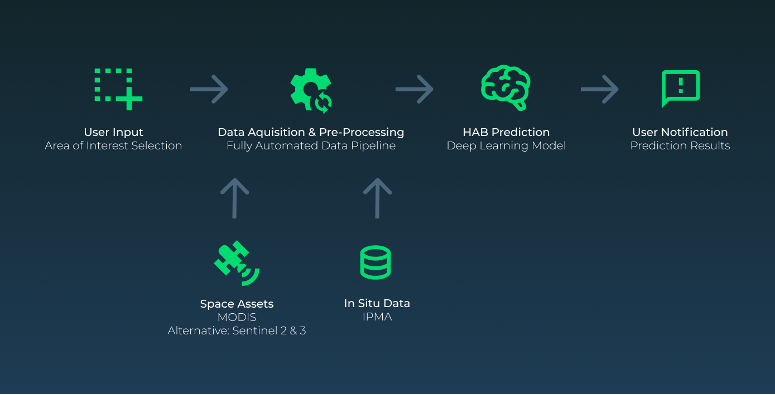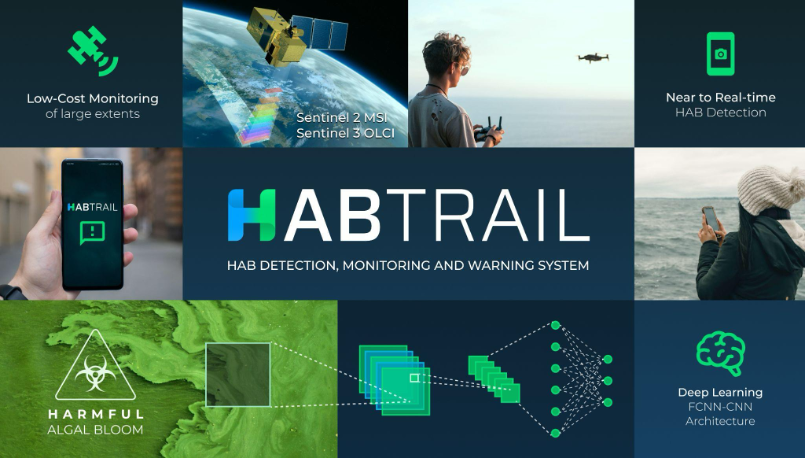
 Data Processing & Visualisation
Data Processing & Visualisation  Data Analytics, Insights & Applications
Data Analytics, Insights & Applications HABTRAIL addresses the challenges posed by Harmful Algal Blooms (HABs), which impact aquaculture, public health, tourism, and insurance sectors. HABs contaminate seafood, disrupt aquaculture operations, cause economic losses, and pose risks to human health. Traditional monitoring methods rely on costly, time-consuming water sampling and lab tests, often leading to delayed responses.
HABTRAIL provides an AI-driven early warning system that accurately predicts HAB occurrences and bivalve toxicity up to three days in advance. The platform integrates satellite and in situ data with advanced machine-learning models to deliver real-time insights.
Users access the predictions through a web dashboard, where they can visualise HAB severity, receive species-specific interdiction forecasts, and configure personalised alerts. Aquaculture operators can optimise harvesting schedules, public health offices can make informed safety decisions, and tourism and insurance entities can manage risks proactively.
By offering predictive analytics and automated alerts, HABTRAIL shifts HAB management from reactive to proactive, reducing financial losses, improving food safety, and ensuring sustainable marine resource use. The platform’s expansion will enhance its accuracy, cover more geographic regions, and incorporate additional environmental factors to support decision-making and regulatory compliance further.
HABTRAIL targets aquaculture entities, national regulatory bodies, public health offices, tourism businesses, and insurance companies. These customers face significant challenges due to Harmful Algal Blooms (HABs), which disrupt operations, endanger public health, and cause economic losses.
HABTRAIL directly involves these stakeholders by providing an AI-powered web dashboard with real-time predictions, automated alerts, and risk assessments, enabling data-driven decisions to mitigate the impact of HABs.
HABTRAIL initially targets Portugal for deployment, focusing on its coastline and estuarine zones. Expansion is planned for Spain, France, and Italy in Europe (Year 2), followed by the USA and Chile in the Americas (Year 3), and later Japan and South Korea in Asia (Year 4-5). These countries have significant aquaculture industries, regulatory bodies for marine monitoring, and coastal tourism sectors affected by Harmful Algal Blooms (HABs).
HABTRAIL is an AI-powered web-based platform that predicts, monitors, and issues early warnings for Harmful Algal Blooms (HABs). It integrates satellite data with machine learning models to forecast HAB severity and bivalve toxicity with over 90% accuracy for the next three days. Users interact with the platform through a web dashboard, where they can visualise HAB severity maps, access species-specific interdiction forecasts, and configure custom alerts via email or SMS.
By shifting from a reactive to a proactive approach, HABTRAIL ensures safer, more sustainable management of marine resources.


HABTRAIL brings significant added value compared to traditional monitoring methods and existing competitors by offering a proactive, AI-driven approach to Harmful Algal Bloom (HAB) prediction.
By transitioning from a reactive to proactive strategy, HABTRAIL minimises financial losses, improves food safety, and enhances environmental protection better than any existing alternative.

HABTRAIL is in an advanced development phase, with key achievements including the successful implementation of AI-driven predictive models, achieving over 90% accuracy in forecasting HAB severity and bivalve toxicity. A functional web dashboard has been developed, providing real-time data visualisation and customisable alerts.
Current work focuses on expanding geographic coverage from the initial L7C2 (Algarve) test zone to the entire Portuguese coastline, refining species-specific interdiction forecasts, and enhancing model precision using additional environmental data.
The User and Technical requirements were validated by Aquaculture Entities and Tourism Entities, gathering feedback for system optimisation, and integrating new features such as pixel-based HAB, SST, Salinity and CHLOR_A predictions, as well as Pollution, Sediments, Tide Levels, and Beach Information. Future expansion plans target Spain, France, and Italy in the next phase.
The project is progressing on schedule, with ongoing validation efforts moving on to the System Design and Data Integration phase, ensuring operational readiness for commercial deployment.
